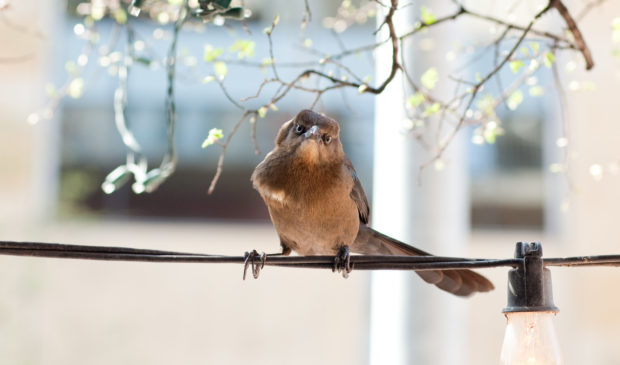Austin bird initiative takes flight
Tuesday, December 7, 2021 by
Jackie Ibarra Bella Ramos is a birder. While she acknowledges that there may be more experienced and knowledgeable birders, she says she is “obsessed with birds.” Ramos and her bird-loving friends had even been turning off their lights to protect migrating birds years before the city of Austin passed a resolution to do so.
Now the ordinary, non-birding population of Austin is attempting to catch up with Ramos and her friends.
The city of Austin and Travis County have both passed resolutions to protect migratory birds. Austin’s resolution calls for non-essential lights in city buildings to be turned off from 11 p.m.-6 a.m. The resolution passed in September is part of a statewide initiative called Lights Out Texas.
Now, in a memo sent Nov. 23, the Building Services Department and the Office of Sustainability provided updates on further plans to protect birds. Facilities managed by Building Services, such as City Hall, One Texas Center, the Central Library, Austin Convention Center and Palmer Events Center, are all participating by turning off non-essential lights from 11 p.m.-6 a.m. during migration season and not using landscape lighting to illuminate trees, gardens and other places where birds may sleep and rest. Participation also includes dimming essential lighting such as security and safety lights when feasible.
Facilities that are not managed by Building Services have been informed of the bird-protection plan.
According to the memo, dark skies-friendly practices are recommended around town, such as aiming lights downward and using lighting shields that direct light downward to avoid shining lights upward into trees or toward the sky. Motion detectors and sensors have also been implemented. Custodial schedules in the BSD have been adjusted to end by 11 p.m. and custodial staffers have been asked to make sure lights are off after their work.
In addition, the city has been working with different organizations to spread the word about the birds. The plan is to collaborate with the Downtown Austin Alliance to involve private building owners in the campaign. The Office of Sustainability plans to use social media channels to get the word out to the public about the Lights Out campaign.
“I noticed a big difference in the amount of light that was coming from downtown buildings once the program took effect,” said Michele Van Hyfte, vice president of urban design for the Downtown Austin Alliance.
Nicole Netherton, executive director of the Travis Audubon Society, is hoping to spread the wings of the initiative even further and make it second nature for Austinites.
“It’s our hope that someday this will be something that people do without even thinking about it, that this will become the practice and that we will have darker skies again even in urban areas,” Netherton said.
Netherton said text alerts would be a way to remind people to turn off their lights, or even reminders on local weather reports when more birds are due to be passing through.
“Slow progress is important. I think a lot of people have no idea that this is even an issue,” Netherton said.
Though turning off lights is a simple concept, implementing the program citywide has its challenges. According to the memo, older buildings and those without on-site staff might require new lighting, lighting controls or staffing to be able to comply with the resolution.
Despite the challenges, the memo adds that next steps will “focus on including additional facilities and departments” and “potentially expanding beyond downtown.” More efforts will focus on education and “empowerment of facility staff, building management, security and custodial employees.”
Ramos hopes the initiative continues to spread. She said even if a bird isn’t a person’s favorite animal, their importance impacts everyone.
“We want these bird species to keep existing here, and to keep the kind of biodiversity that we have, we need to be protecting these birds,” Ramos said. “We all know Austin is only getting bigger; it’s growing every day.”
“If we don’t start taking action now,” she added, “we might not have a chance to kind of prevent these kind(s) of catastrophic species-wide or migration-wide changes.”
After all, millions of birds can be helped with just the flick of a switch.
“An individual turning off their porch light might not make a huge difference,” Ramos said. “But an entire city like Austin that is so situated smack in the middle of Texas has the potential to be a really important area for all of these species that converge through Texas.”
This story was written by a journalism student at the University of Texas at Austin. The Austin Monitor is working in partnership with the UT School of Journalism to publish stories produced by students in the City and County Government Reporting course.
Photo made available through a Creative Commons license.
The Austin Monitor’s work is made possible by donations from the community. Though our reporting covers donors from time to time, we are careful to keep business and editorial efforts separate while maintaining transparency. A complete list of donors is available here, and our code of ethics is explained here.
You're a community leader
And we’re honored you look to us for serious, in-depth news. You know a strong community needs local and dedicated watchdog reporting. We’re here for you and that won’t change. Now will you take the powerful next step and support our nonprofit news organization?



